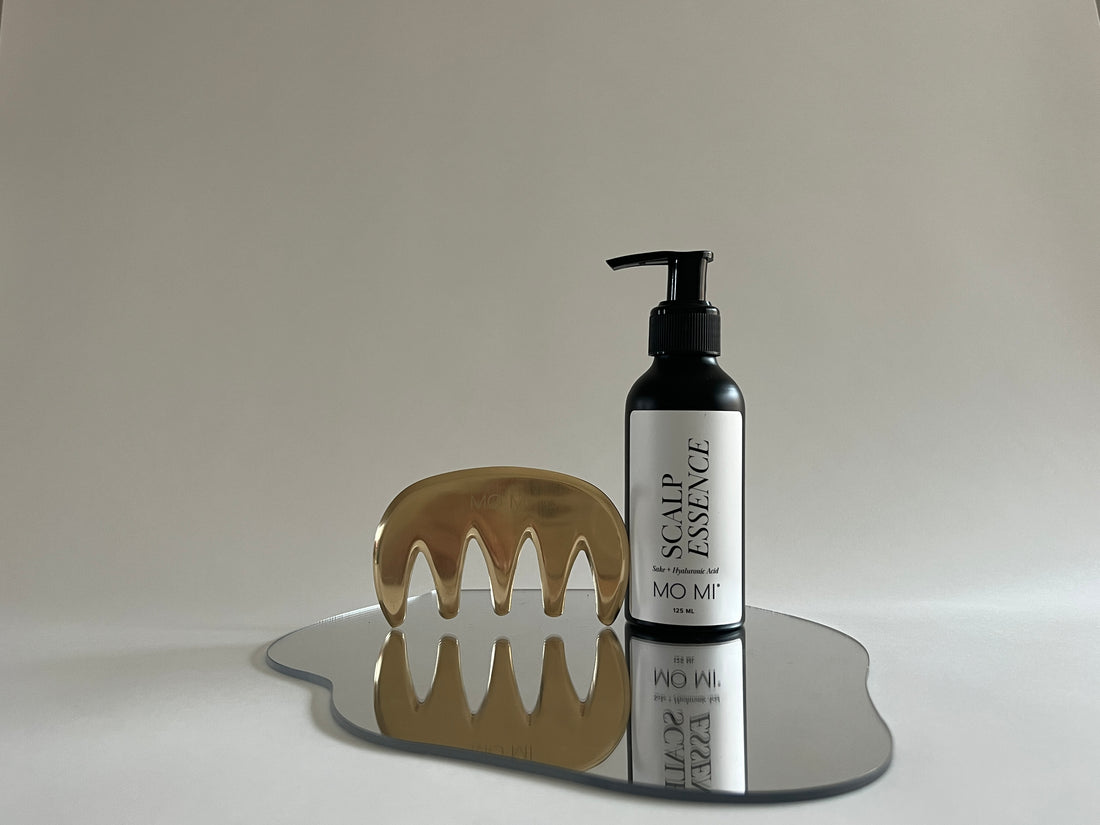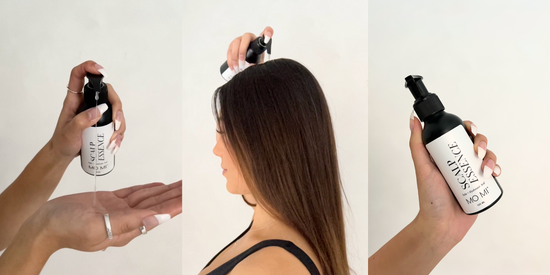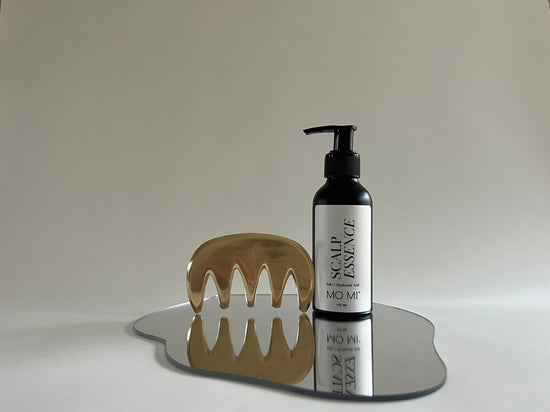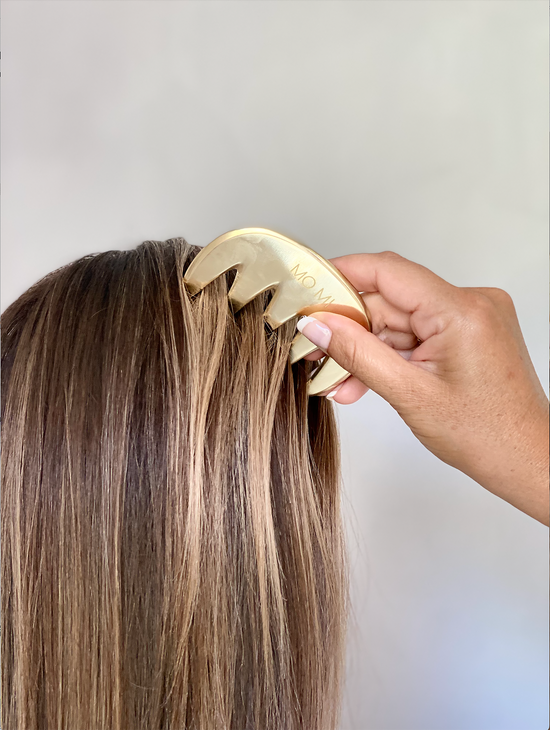How an ancient practice could help you slow down thinning and stimulate healthy hair growth
By Kate Downes, MSAOM, Chinese Medicine Practitioner
Losing hair is normal. In fact, the average person loses up to 100 hairs per day! But when you start waking up to more and more hairs on your pillow or in your shower drain, it could be a sign of early hair loss.
Combing therapy for hair loss is a natural way you can fight this excess shedding and keep your hair healthy for years to come. Discover how this ancient technique could be the holistic hair care answer you’re looking for.
Why Am I Losing My Hair?
Noticing new bald patches or thinning areas can be frustrating and even worrying. Hair loss isn’t just something that happens as you age. It can be a response to medication, the onset of male pattern baldness or female pattern baldness, a symptom of a medical condition, or simply a sign that your scalp needs some extra TLC.
No matter what the root cause of your hair loss is, combing therapy offers a simple and natural way to support your scalp health and encourage hair growth.
Since combing therapy originated as part of the holistic healing system of Chinese medicine (TCM), it’s important to understand how TCM views hair loss. From this perspective, there are a few common causes of hair loss:
-
Stagnation
Healthy hair requires open, flowing blood vessels to nourish the follicles and promote growth. When lifestyle issues cause the qi (energy) and blood to stagnate, the follicles don’t get the nutrients they need to survive and they become dormant.
Stagnation might be causing your hair loss if you often struggle with frustration, stress, pain, or headaches. By opening up the channels and blood vessels of the scalp with combing therapy, we invite free-flowing blood and qi back to the area to revitalize these follicles and prevent future damage.
-
Heat
The heat of fire rises and scorches anything in its path. Unfortunately, heat in the body does the same. Inflammation in the body can cause yang (or warming) energy to become unbalanced and rise to the head. Here, it damages the hair follicles and prevents healthy hair growth.
If you have symptoms related to rising heat (like headaches, high blood pressure, inflammatory skin conditions, or red eyes), heat may be the underlying cause of your hair loss. Use combing therapy to stimulate the follicles and clear heat from the head.
-
Deficiency
Healthy hair growth requires a surplus of both qi and blood. If we are low on these resources, the body will reserve them for more important things than growing hair – like maintaining our internal organ systems.
If you feel weak, fatigued, or have suffered from a chronic illness, a deficiency could be at the root of your hair loss. In addition to trying combing therapy, take time to rest and adopt habits that build up your energy.
Curious how a seemingly simple comb could help you keep your hair? Combing therapy works by stimulating specific acupoints and channels along the head. As this area is stimulated, it not only brings circulation to the scalp and hair follicles but also regulates the function of your internal organs for better overall health.
-
Combing therapy brings healthy circulation to the hair follicles.
When hair follicles don’t get proper blood flow, they can no longer maintain the hair growth cycle. Just as massage releases tension and flushes your muscles with healthy blood flow, combing therapy helps restore healthy circulation to the follicles so they can stay clean, nourished, and continue producing healthy hair.
-
Combing therapy strengthens the hair.
If your hair gets thinner the longer it gets, you could have a problem with breakage. Combing therapy helps prevent hair breakages by nourishing hair from root to tip. Healthy hair begins with a healthy scalp. Combing therapy ensures good circulation to the scalp and reduces tension or clogged follicles. MO MI’s gua sha comb is gentle on hair to prevent breakage, while botanical compounds from our scalp essence restore strength and shine to the hair shaft.
-
Combing therapy relieves stress.
Hair loss and thinning can be triggered or worsened when we’re under stress. Combing therapy is an easy stress-relief ritual you can do from almost anywhere to keep stress at bay while protecting your scalp. Studies show that stimulating the head and scalp with techniques like combing therapy has a powerful calming effect on the nervous system. A few minutes of combing can take you from a fight-or-flight stress response into a relaxed and focused state.
How to Use Combing Therapy for Hair Loss at Home
If you want to slow down or prevent thinning hair or hair loss, add combing therapy to your daily self-care routine. It’s easy to do and just takes a few minutes! Practice these four steps both morning and night to stimulate your scalp and strengthen your hair.
-
Prep. You can use combing therapy on dry or damp hair. For the best results, use a comb and scalp essence specifically designed for combing therapy, like MO MI's Combing Therapy Duo.
-
Glide. Apply a Scalp Essence to your scalp if using. Place the scalp gua sha tool or comb on your forehead at the hairline. Apply light to medium pressure (enough to feel some tenderness, but not uncomfortable). Glide the tool backward making one smooth movement from forehead to nape.
-
Comb the entire scalp. Move in slow, long strokes from the crown of your head to the nape of your neck, covering the entire scalp. Make at least 3-5 passes over each section. Spend extra time on areas of thinning or hair loss, as well as above and below the area. This will encourage healthy blood flow throughout.
-
Reverse and repeat. Drop your head down and repeat the process, this time moving from nape to forehead. Make at least 3-5 passes over each section, again spending more time on areas of thinning or loss.
Interested in indulging in a gua sha practice and discovering your accupoints? We recommend contacting your TCM Doctor to guide you through the practice, tailored to your body's personal requirements!





